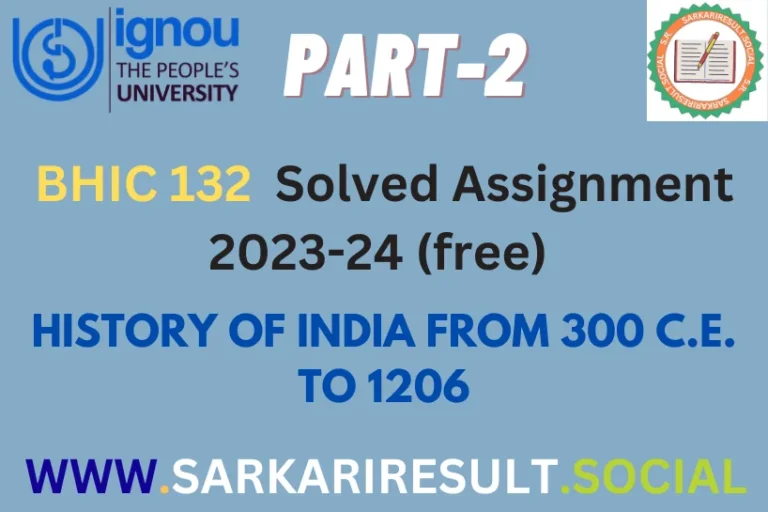BPCG 171 SOLVED IGNOU ASSIGNMENT FREE PART 2

Welcome to the BPCG 171 SOLVED IGNOU ASSIGNMENT FREE PART 2 TMA. Assignment – II streamlines your approach with concise answers to three pivotal questions. In about 250 words each, unravel the intricacies of intelligence theories, elaborate on the laws of perception, and explore models of memory. Our IGNOU Solved Assignments 2024 for this section serve as your creative guide.

Answer the following questions in about 250 words each.
Q.3 Discuss the various theories of intelligence.
Ans. Various Theories of Intelligence:
1. Spearman’s Two-Factor Theory:
– Definition: Spearman proposed a general factor, g (for general intelligence), and specific factors, s (for specific abilities). He believed that g contributes to performance across various cognitive tasks.
2. Gardner’s Multiple Intelligences Theory:
– Definition: Howard Gardner identified multiple intelligences, including linguistic, logical-mathematical, spatial, musical, bodily-kinesthetic, interpersonal, intrapersonal, naturalistic, and later, existential intelligence. This theory emphasizes diverse ways individuals can excel.
3. Cattell’s Fluid and Crystallized Intelligence:
– Definition: Cattell distinguished between fluid intelligence (problem-solving, adaptability) and crystallized intelligence (accumulated knowledge and skills). Fluid intelligence tends to decline with age, while crystallized intelligence may increase.
4. Binet-Simon Scale and IQ:
– Definition: Binet and Simon developed the first intelligence test, assessing mental age compared to chronological age. The concept of Intelligence Quotient (IQ) emerged, representing a ratio of mental age to chronological age.
5. Triarchic Theory of Intelligence (Sternberg):
– Definition: Robert Sternberg proposed three aspects of intelligence: analytical (problem-solving), creative (innovative thinking), and practical (adaptation to real-world situations). This theory emphasizes the contextual nature of intelligence.
6. Emotional Intelligence (Goleman):
– Definition: Daniel Goleman introduced emotional intelligence, encompassing self-awareness, self-regulation, motivation, empathy, and social skills. It highlights the importance of emotional competencies in personal and social success.
7. Intelligence as Processing Speed (Vernon):
– Definition: Vernon suggested that intelligence is related to the speed and efficiency of information processing. Higher intelligence implies quicker cognitive processing.
8. Componential, Experiential, and Contextual Subtheories (Sternberg):
– Definition: Sternberg’s later work proposed three subtheories: componential (analyzing information), experiential (applying past experiences), and contextual (adapting to the environment). This reflects a broader view of intelligence.
9. Theory of Successful Intelligence (Sternberg):
– Definition: Sternberg’s successful intelligence involves adapting to, shaping, and selecting environments to achieve one’s goals. It combines analytical, creative, and practical abilities for effective problem-solving.
10. Information Processing Theory:
– Definition: This theory views intelligence as a product of cognitive processes such as memory, attention, and perception. It emphasizes how individuals process and manipulate information.
11. Biological Theories of Intelligence:
– Definition: These theories explore the genetic and neurological foundations of intelligence. Factors like brain size, neural efficiency, and genetic predispositions are considered.
12. Theory of Multiple Intelligences (Thurstone):
– Definition: Thurstone identified seven primary mental abilities, challenging the idea of a single intelligence factor. These abilities include verbal comprehension, numerical ability, spatial relations, perceptual speed, and more.
Q.4 Elaborate upon the various laws of perception.
Ans. Various Laws of Perception:
1. Law of Proximity:
– Definition: Elements that are close to each other are perceived as a unified group or pattern.
– Example: Rows of dots placed close together are perceived as lines rather than individual dots.
2. Law of Similarity:
– Definition: Similar elements are perceived as belonging to the same group or category.
– Example: Arrays of circles and squares; circles are perceived as one group, and squares as another.
3. Law of Closure:
– Definition: Incomplete figures are perceived as whole when other elements complete the structure mentally.
– Example: A partially drawn circle is perceived as a complete circle.
4. Law of Continuity:
– Definition: Lines or patterns that follow a smooth, continuous path are perceived as a single unit.
– Example: A curving line is seen as one continuous line rather than a series of separate segments.
5. Law of Common Fate:
– Definition: Elements that move together in the same direction are perceived as part of a single entity.
– Example: A group of birds flying in the same direction is perceived as a flock.
6. Law of Prägnanz (Law of Good Figure):
– Definition: People tend to perceive objects in their simplest form.
– Example: Olympic rings are simplified, facilitating quick recognition.
7. Law of Symmetry:
– Definition: Symmetrical images are perceived as more appealing and stable.
– Example: A symmetrical face is often considered more attractive.
8. Law of Figure-Ground:
– Definition: The perceptual field can be divided into a figure (the main object of focus) and a ground (the background).
– Example: In a picture of a tree against a blue sky, the tree is the figure, and the sky is the ground.
9. Law of Isolation:
– Definition: A distinct element is likely to be noticed and remembered more than other elements.
– Example: A red flower in a sea of green foliage stands out and is more likely to be noticed.
10. Law of Depth Perception:
– Definition: Perceptions of depth and distance are influenced by cues such as overlap, size, and convergence.
– Example: A person appears larger when closer and smaller when farther away.
11. Law of Color Perception:
– Definition: The way color is perceived is influenced by surrounding colors.
– Example: A gray square surrounded by red appears different from the same gray square surrounded by blue.
These laws, often attributed to Gestalt psychology, explain how individuals organize and interpret visual information. They highlight the brain’s tendency to create meaningful patterns and structures from sensory input, emphasizing the role of cognitive processes in perception.
Q.5 Explain the models of memory.
Ans. Models of Memory:
1. Atkinson-Shiffrin Model (Multi-Store Model):
– Definition: Proposed by Atkinson and Shiffrin, this model comprises three memory stores: sensory memory, short-term memory (STM), and long-term memory (LTM). Information flows sequentially through these stores, with rehearsal playing a key role in transferring information from STM to LTM.
2. Working Memory Model (Baddeley and Hitch):
– Definition: Baddeley and Hitch’s model expands on the STM concept in the Atkinson-Shiffrin model. It introduces the concept of working memory, which includes the central executive (attentional control) and subsystems for visual-spatial information and auditory information (phonological loop). It emphasizes the active processing of information within working memory.
3. Levels of Processing Model (Craik and Lockhart):
– Definition: This model focuses on the depth of processing as a crucial factor in memory. It suggests that information is better remembered when it is processed more deeply, involving semantic analysis, as opposed to shallow processing involving only superficial characteristics.
4. Parallel Distributed Processing Model (Connectionist Model):
– Definition: Also known as the connectionist or neural network model, it proposes that memory is distributed across a network of interconnected nodes or units. Information is stored in a parallel fashion, allowing for simultaneous processing and retrieval.
5. Information Processing Model:
– Definition: This model likens the human mind to a computer, emphasizing the processing of information through various stages, including encoding, storage, and retrieval. It incorporates concepts like sensory registers, short-term memory, and long-term memory.
6. Dual Coding Theory (Paivio):
– Definition: Paivio’s theory posits that information is processed through both verbal (linguistic) and non-verbal (imaginal) systems. This dual coding enhances memory retention, especially when information is encoded using both systems.
7. Schema Theory:
– Definition: Schema theory suggests that prior knowledge and experiences organize information into mental frameworks or schemas. These schemas influence encoding and retrieval, helping individuals make sense of new information based on existing mental structures.
8. Constructive Memory Model (Bartlett):
– Definition: Bartlett proposed that memory is not a perfect recording of past events but is influenced by cognitive processes. Individuals actively reconstruct memories based on personal interpretations, experiences, and cultural influences.
9. Episodic Buffer (Baddeley):
– Definition: Baddeley expanded the working memory model by introducing the episodic buffer, which integrates information from different sources into a single episodic representation. It serves as a temporary storage system for diverse types of information.
These models provide frameworks for understanding how information is processed, stored, and retrieved in the human memory system. They highlight the dynamic and multifaceted nature of memory, acknowledging the role of cognitive processes, attention, and organization in shaping our ability to remember and recall information.
Also See This: BPCG 171 SOLVED IGNOU ASSIGNMENT FREE PART 3







